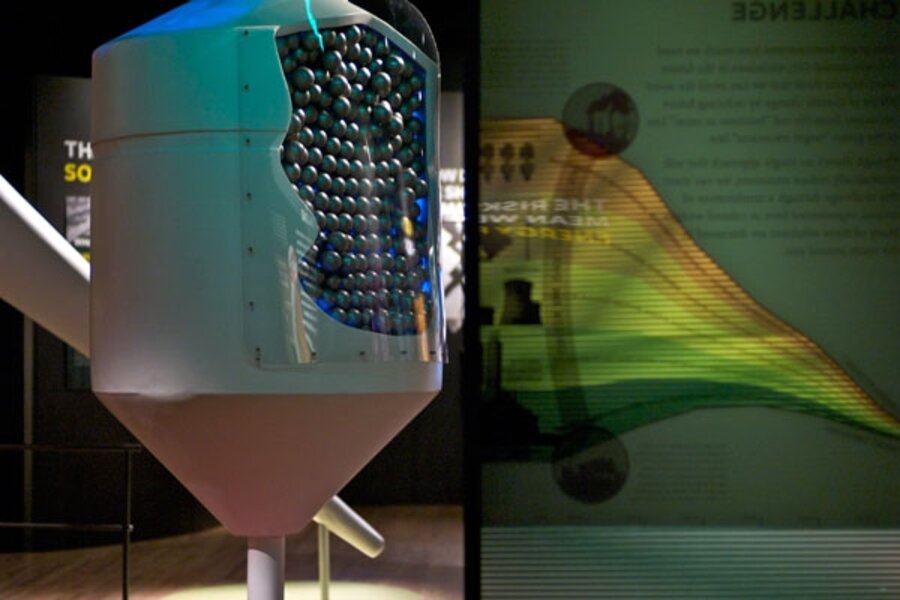Will talking change anyone's mind about climate change?
Loading...
On Wednesday, Columbia University's Center for Research on Environmental Decisions released a guide titled "The Psychology of Climate Change Communication."
Freely available online [pdf], the manual endeavors to describe the various biases and barriers that lurk in the minds of the general public, and that, as the authors see it, confound an accurate comprehension of climate science and its ramifications.
In concept, at least, the manual's arrival is timely.
In case you missed it, a poll conducted by the Pew Research Center for the People & the Press last month found that the number of people who think there's solid evidence of human-induced climate change has declined dramatically in the past few years.
Fifty-seven percent of respondents now believe it's happening, down from 77 percent in 2006.
The guide has eight chapters:
1. Know Your Audience.
2. Get your Audience's Reaction.
3. Translate Scientific Data Into Concrete Experience.
4. Beware the Overuse of Emotional Appeals.
5. Address Scientific and Climate Uncertainties.
6. Tap Into Social Identities and Affiliations.
7. Encourage Group Participation.
8. Make Behavior Changes Easier.
Following are a few tidbits that caught this reporter's eye.
Chapter 1
The authors explain "mental models" — "a person's thought process for how something works." Understanding the audience's mental model and its inherent biases is key to successfully imparting information.
There's an interesting example from Anthony Leiserowitz, director of Yale's Project on Climate Change. He has observed that mental models of the ozone layer hole and climate change are often conflated, and that this conflation leads to inaccuracies.
Paradoxically, this conflation is due in part to scientists' and the media's success in communicating the gravity of the ozone problem in past decades. Legislation followed and CFCs are (almost) phased out. But now, as the public grapples with a different issue — climate change from "greenhouse gases" — some wonder why we can't just bring back CFCs to reopen the ozone hole and release the trapped heat.
The problem is with the "greenhouse" metaphor. The two descriptors — "ozone hole" and "greenhouse gases" — have together fostered a misconception of how the science behind human-induced climate change works.
Presumably, if a communicator knows about this faulty mental model in advance, he can account for it in his explanations and, it's to be hoped, even correct it.
Chapter 4
People don't have an infinite capacity to worry, note the authors. Researchers call that limited fretting capacity "a finite pool of worry." And there's competition for space in this pool. If a person begins worrying about one risk, he or she will likely begin worrying less about another. In this constant competition, short-term threats beat out long-term ones.
That partly explains the apparent decline in belief about global warming, as measured by the Pew poll: Since the economic implosion of 2008, the economy has taken center stage, leaving little room for other concerns.
So how to get climate back into the spotlight? The manual doesn't say exactly, advising, only that would-be communicators should be aware of what else is floating around the worry pool.
But it does mention another risk – piling on too much anxiety-inducing information at once: "emotional numbing." That's when an exposure to a multitude of problems overwhelms, and makes one less likely to care about much about any of them.
Chapter 5
People don't like uncertainties. Unfortunately, climate science — and science in general — tries to be upfront about uncertainties. That's why scientists use language riddled with caveats, and why they often seem to speak in the conditional tense.
The authors argue that, although people prefer certainty, it's important to communicate uncertainties when they exist.
Indeed, that was the thinking behind sentences like "Most of the observed increase in global average temperatures since the mid-20th century is very likely due to the observed increase in anthropogenic GHG [greenhouse gas] concentrations," which appears in the Summary for Policymakers from the Intergovernmental Panel on Climate Change
The problem, say the authors, is that an honest attempt to express real uncertainties may come across as vagueness to laypeople, who then conclude that the scientists aren't really certain about much, so it's best to ignore them entirely.
To avoid this, the authors recommend nipping far-out interpretations in the bud by including absolute numbers next to probabilistic verbiage. "Very likely" in the sentence above, for example, could have a "90 percent or greater likelihood" parenthetical next to it, which is what the IPCC scientists mean.
Of course, the authors offer no advice on how to better explain the statistical analyses that produced the 90 percent figure, which surely lies at the root of much doubt.
Chapter 8
This chapter details "default effects" — "the human tendency to stick with the option that is selected automatically instead of choosing an alternate option" — and suggests that people seeking to make human behavior more enviro-friendly take advantage of it.
A case study: Rutgers University saved many trees simply by changing the default setting on printers in school computer labs from "single-sided" to "double-sided." After the switch, students had to manually select "single-sided" if they wanted it. Most didn't care and, ultimately, this small alteration saves nearly 7.4 million sheets of paper, or 1,280 trees, during the academic year.
The manual concludes on a hopeful note:
"Social science research provides compelling evidence for an optimist’s view that climate change communicators can reach both policymakers and the public, informing and inspiring them to address climate change."
Editor’s note: For more articles about the environment, see the Monitor’s main environment page, which offers information on many environment topics. Also, check out our Bright Green blog archive and our RSS feed.





